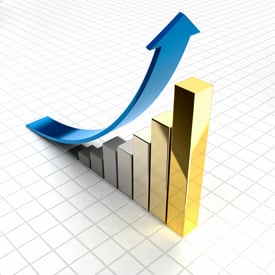Looking Ahead to 2016
Forecasting today's volatile, high-frequency machine-driven, and manipulated futures markets using fundamental analysis is futile, as a great many precious metals bulls will attest. To complicate matters, an obsession with Fed policy dominates all markets. Officials at the Federal Reserve are often less than forthcoming and are just as bumbling as the Soviet bureaucrats when it comes to centrally planning our economy.
Nevertheless, beneath all of the artificial influences and all of the leveraged paper, the gears of the physical market for gold and silver still turn. We can be sure prices will reflect actual supply and demand for physical metals at some point, even if we do not know when. With that in mind, here is a look ahead to 2016...
Supply Destruction
Silver production peaked in 2014, while gold production is expected to peak in 2015. Falling prices make an increasing number of mining projects uneconomic. Lower fuel costs are helping, but the average all-in cost of production for silver is estimated at around $17/oz and for gold at around $1,150/oz.
Today precious metals sell well below their all-in production cost. Primary producers of gold and silver will deliver less to market in 2016 given that a great many miners currently take a loss on every ounce they sell.
But there is another factor likely to decimate supply in 2016. Base metal prices, including copper, fell dramatically this year, and the outlook is not too bright for the year ahead. The Chinese economy, the world's largest market for commodities, is slowing. Brazil is in real trouble and economists are worrying more about the possibility of recession around the world.
 Slumping demand for base metals will impact the supply of gold and silver because huge quantities of these precious metals are produced as a byproduct of mining for base metals such as copper and zinc. The reorganization of Anglo-American PLC, one of the world's largest mining conglomerates, earlier this month highlights just how difficult the current environment is for producers - regardless of which metal they are mining.
Slumping demand for base metals will impact the supply of gold and silver because huge quantities of these precious metals are produced as a byproduct of mining for base metals such as copper and zinc. The reorganization of Anglo-American PLC, one of the world's largest mining conglomerates, earlier this month highlights just how difficult the current environment is for producers - regardless of which metal they are mining.
Gold and silver prices have been in decline since 2011, but it is only during the past year that average prices will finish well below even the most conservative estimates of production costs. The recent carnage in base metals will add significantly to constraints on precious metals supply in the months ahead.
Physical Demand Rising
Investment demand for physical bullion is perhaps the biggest story in precious metals for 2015. Mints and refiners spent much of the 2nd half of the year unable to keep up. Investors had to contend with higher premiums and delivery delays, finally getting some relief now as the year draws to a close.
Only time will tell if 2016 can top this year's record. We look set to enter the New Year in much the same way we entered 2015 – with steady, but far from overwhelming buying activity for fabricated coins, rounds, and bars. Investors loaded up in recent months and now await the next catalyst.
 It may be price action. Lower spot prices over the past 4 years have been a big driver of demand. And prices moving consistently higher will also inspire demand from newcomers (as we saw during the last bull cycle between 2009 – 2011). Only flat or range-bound prices typically lead to investor apathy.
It may be price action. Lower spot prices over the past 4 years have been a big driver of demand. And prices moving consistently higher will also inspire demand from newcomers (as we saw during the last bull cycle between 2009 – 2011). Only flat or range-bound prices typically lead to investor apathy.
As always, geopolitical events will play a big part in whether or not metals benefit from safe-have buying. In 2016, investors will be watching the ongoing saga surrounding Greece and other hopelessly indebted European nations. The U.S. is at odds with Russia in the Middle East and Ukraine.
And recent tremors in high-yield debt markets may be an advance warning that extraordinary leverage is about to rock financial markets once again. These stories, and others no one can predict, have the potential to generate a flight to safety in the coming year.
Industrial demand for gold and silver may turn out to be tepid for 2016. This is less of a factor in gold markets than for silver, where manufacturers consume a good portion of what is produced annually. As mentioned above, some economists worry about the possibility of a recession in the coming year. Any slump will weigh on demand for items such as jewelry and other goods. However, a lot of industrial demand comes from high-growth sectors which have proven resilient during past recessions. Electronic, solar, and healthcare-related applications for silver come to mind.
Some 2016 Wildcards
Delivery defaults are possible in the futures markets. The explosion of leverage in COMEX gold futures bears watching in 2016. The number of registered bars available for delivery in exchange vaults relative to the number of paper ounces being traded shrunk dramatically to record lows in recent weeks. It's a trend that simply cannot go on very much longer – not at the current pace of decline.
 Exchange participants may convert more gold stocks from “eligible” to the “registered” category. That's possible, though there is good reason to wonder how much physical metal the holders want to part with at current prices. The precipitous drop in registered stocks may well be signaling they are more than a little reluctant to part with it.
Exchange participants may convert more gold stocks from “eligible” to the “registered” category. That's possible, though there is good reason to wonder how much physical metal the holders want to part with at current prices. The precipitous drop in registered stocks may well be signaling they are more than a little reluctant to part with it.
If holders of silver and gold futures contracts start standing for actual delivery of more metal than the COMEX has available to deliver, or should traders even begin to seriously entertain that possibility, we'll see some fireworks.
Leading Republican candidates are making noises about sound money. Donald Trump, Ted Cruz, Rand Paul, and Ben Carson all have questioned the wisdom of Fed policy. Republicans everywhere are critical of federal debt and deficits and have been for decades now. Given the Party's atrocious record of turning the talk into actual policy, we should remain skeptical that any elected Republican leader will achieve reform.
But there can be no doubt that the sound money issue is gaining traction. We can't rule out someone in the crowded field of candidates tapping into the popular outrage over out-of-control borrowing and spending. Should ideas like reinstituting gold backing for the dollar gain serious momentum in the campaign, the metals markets could perk up.

About the Author:
Clint Siegner is a Director at Money Metals Exchange, a precious metals dealer recently named "Best in the USA" by an independent global ratings group. A graduate of Linfield College in Oregon, Siegner puts his experience in business management along with his passion for personal liberty, limited government, and honest money into the development of Money Metals' brand and reach. This includes writing extensively on the bullion markets and their intersection with policy and world affairs.





